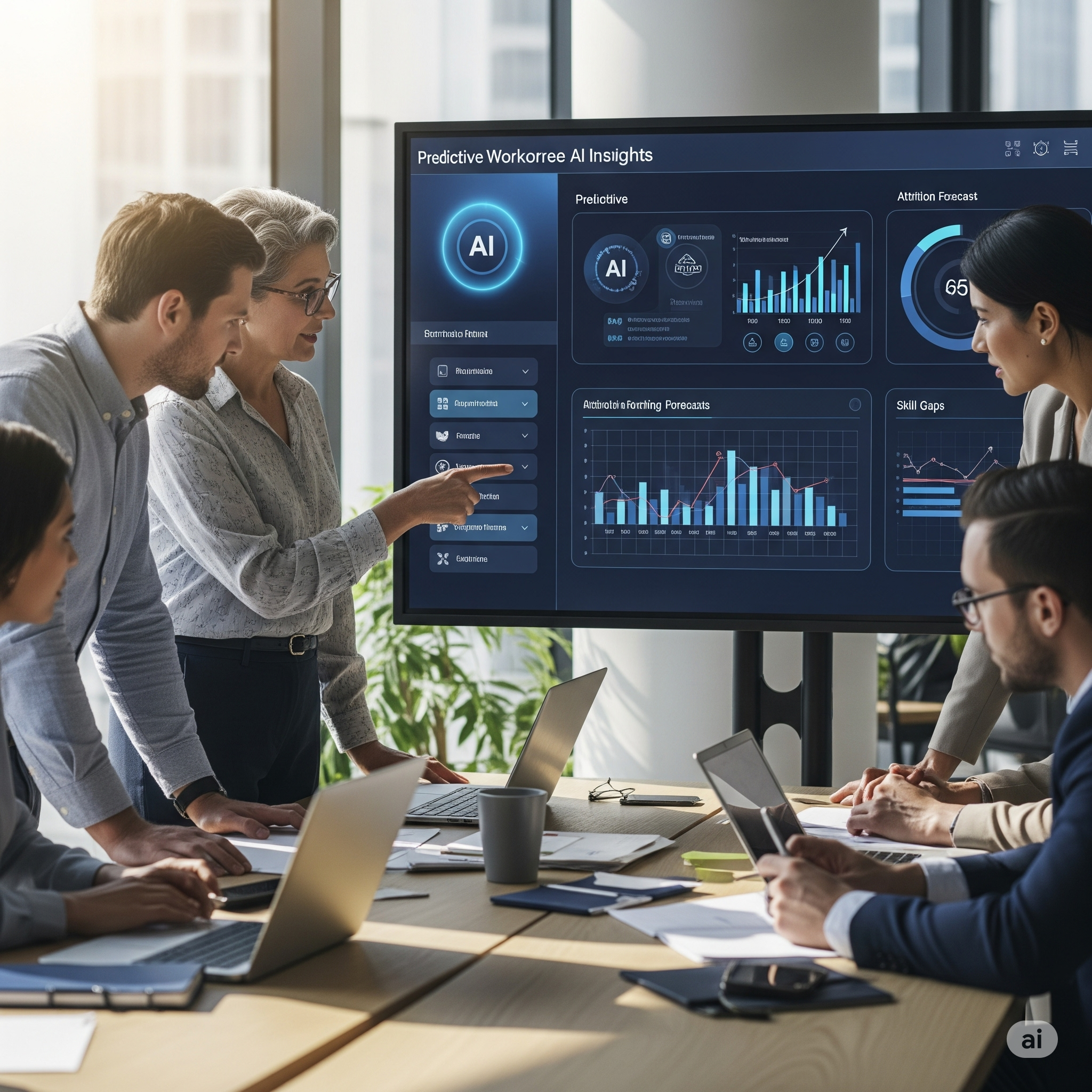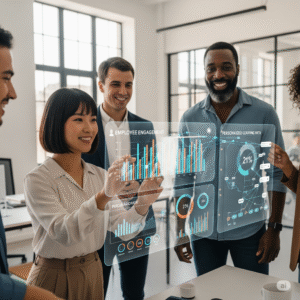The HR function has undergone a seismic shift in recent years, moving beyond purely administrative tasks to become a strategic partner in organizational success. At the heart of this transformation lies data, and the ability to extract meaningful, forward-looking insights from it. Enter Artificial Intelligence (AI), the game-changer for Human Resources analytics. AI HR analytics is empowering organizations to not just understand their workforce, but to predict future trends, proactively address challenges, and make data-driven decisions that directly impact business outcomes. This isn’t about replacing human intuition, but augmenting it with powerful, objective insights, leading to more intelligent workforce planning AI.
In a world where talent is the ultimate competitive advantage, the ability to forecast staffing needs, anticipate attrition, identify skill gaps, and optimize employee engagement is paramount. Traditional HR reporting, often backward-looking, simply can’t keep pace with the demands of today’s dynamic business environment. AI HR analytics fills this void, offering predictive capabilities that allow HR leaders to move from reactive problem-solving to proactive strategic planning. By processing vast datasets with unprecedented speed and accuracy, AI provides insights that were previously impossible to uncover, redefining the role of HR as a genuine driver of business growth.
Personalizing Employee Experience with AI: From Onboarding to Retention
The Power of Prediction: How AI HR Analytics Transforms Strategic Workforce Planning
Strategic workforce planning is about having the right people with the right skills in the right place at the right time. This complex endeavor involves numerous variables, making accurate forecasting a significant challenge. This is where AI HR analytics truly shines, providing predictive insights that enable more precise and agile workforce planning.
Instead of relying on historical trends or educated guesses, AI models can analyze a multitude of factors to predict future talent needs. This includes:
- Attrition Forecasting: AI can analyze historical turnover data, employee demographics, engagement survey results, compensation trends, and even external market conditions to predict which employees are at risk of leaving the organization. By identifying these individuals or groups early, HR can implement targeted retention strategies, saving significant costs associated with recruitment and onboarding. This predictive power is a cornerstone of effective workforce planning AI.
AI HR analytics
- Skill Gap Prediction: As industries evolve, so do the required skill sets. AI can analyze internal performance data, project requirements, and external market trends to identify emerging skill demands and anticipate future skill gaps within the current workforce. This allows organizations to proactively invest in upskilling and reskilling programs, ensuring their talent remains relevant and capable.
- Hiring Demand Forecasting: AI can integrate data from sales forecasts, project pipelines, market expansion plans, and historical hiring patterns to accurately predict future recruitment needs. This helps organizations avoid overstaffing or understaffing, optimize recruitment budgets, and ensure a healthy talent pipeline.
- Performance and Productivity Prediction: By analyzing various data points related to employee engagement, well-being, workload, and team dynamics, AI HR analytics can even predict potential dips in performance or identify factors that contribute to higher productivity. These insights enable proactive interventions and optimization of work environments.
The benefits of these predictive capabilities are profound. They allow HR to move from being a reactive support function to a proactive strategic partner, capable of influencing business direction and driving competitive advantage through optimized human capital management.
The Dawn of a New Era: Revolutionizing Performance Management with AI
Real-World Impact: Case Studies in Workforce Planning AI
Companies across diverse sectors are already leveraging AI HR analytics to make smarter, more data-driven decisions about their workforce.
Case Study 1: Optimizing Staffing at a Global Retail Chain
A prominent global retail chain was struggling with optimizing staffing levels across its thousands of stores. Traditional methods led to frequent overstaffing during slow periods and understaffing during peak seasons, impacting both profitability and customer experience. They implemented an AI HR analytics platform that integrated sales data, foot traffic patterns, local events, historical workforce data (attendance, shift patterns, turnover), and even local weather forecasts.
The workforce planning AI solution used machine learning to predict hourly staffing needs for each store with remarkable accuracy. It could forecast demand weeks in advance, allowing store managers to create optimized schedules that minimized labor costs while ensuring adequate coverage for peak customer periods. This led to a 15% reduction in labor costs due to optimized scheduling and a noticeable increase in customer satisfaction scores during busy times, demonstrating the direct profit impact of data-driven workforce planning.
Case Study 2: Reducing Attrition at a Tech Consulting Firm
A rapidly growing tech consulting firm faced high attrition rates, particularly among its top-performing employees, which severely impacted project continuity and client relationships. They deployed an AI HR analytics system to identify early warning signs of potential turnover. The AI analyzed a combination of internal data points, including:
- Employee engagement survey results (sentiment analysis of open-ended feedback)
- Frequency and nature of 1:1 meetings with managers
- Project assignments and workload patterns
- Compensation and promotion history
- Internal mobility requests
The AI HR analytics platform generated weekly “attrition risk” scores for individuals and teams, alerting HR business partners and managers to intervene proactively. Interventions included personalized career development discussions, adjustments to workload, mentorship opportunities, or even proactive compensation reviews. Within 18 months, the firm reported a 20% decrease in voluntary attrition among high-potential employees, saving millions in recruitment and training costs and stabilizing project teams. This proactive approach, driven by workforce planning AI, transformed their retention strategy.
Key Applications of AI HR Analytics Beyond Planning
While workforce planning is a significant beneficiary, the capabilities of AI HR analytics extend across the entire HR lifecycle, offering predictive insights in numerous areas:
- Talent Acquisition Optimization: AI can predict the success of new hires by analyzing candidate data against historical performance metrics. It can also identify optimal sourcing channels and predict time-to-fill for various roles, improving recruitment efficiency.
- Employee Engagement & Experience: Beyond surveys, AI can analyze communication patterns, internal platform usage, and sentiment in free-text feedback to provide real-time insights into employee morale and identify nascent issues like burnout or disengagement. This allows for proactive interventions to enhance the overall employee experience.
- Learning & Development Personalization: AI can predict future skill demands and an individual’s learning trajectory, recommending personalized training modules and development paths to close skill gaps effectively. This ensures that training investments yield maximum returns.
- Diversity, Equity, and Inclusion (DEI): AI can identify and mitigate biases in hiring, promotion, and compensation processes by analyzing data for patterns that might indicate systemic inequalities. It can also predict the impact of DEI initiatives, allowing organizations to refine their strategies for a more inclusive workplace.
- Compliance and Risk Management: AI can monitor HR data for compliance risks, flag anomalies, and predict potential legal or ethical issues before they escalate, safeguarding the organization.
The breadth of applications underscores how AI HR analytics is becoming an indispensable tool for forward-thinking HR departments.
Essential Tools for Implementing AI HR Analytics
To leverage the power of AI HR analytics, organizations need the right tools. These platforms often integrate data from various HR systems (HRIS, ATS, LMS) to provide a unified view. Here are some categories of tools and specific examples:
- Dedicated HR Analytics Platforms: These are purpose-built for people analytics and often incorporate advanced AI/ML capabilities for predictive insights.
- Visier (https://www.visier.com/): A leading people analytics and workforce planning platform that provides predictive insights into attrition, talent gaps, and more.
- Culture Amp (https://www.cultureamp.com/): While known for engagement surveys, it uses AI to provide predictive insights from employee feedback, helping organizations understand and act on engagement trends.
- Workday Peakon Employee Voice (https://www.workday.com/products/human-capital-management/peakon/): Part of the Workday suite, it offers continuous listening and AI-powered sentiment analysis for actionable engagement insights.
AI HR analytics
- Business Intelligence & Data Visualization Tools: While not purely HR-focused, these are critical for building custom dashboards, visualizing HR data, and conducting ad-hoc analysis.
- AI/ML Platforms & Libraries (for advanced users): For organizations with in-house data science teams, direct use of AI/ML frameworks allows for highly customized model development.
- OpenAI API (https://openai.com/business/): Can be leveraged for natural language processing tasks like sentiment analysis of employee feedback or generating summaries from open-ended survey responses, providing rich textual insights for AI HR analytics.
- Python (with libraries like Pandas, Scikit-learn, TensorFlow): The go-to programming language for data science, allowing HR data scientists to build custom predictive models for attrition, performance, or skill forecasting.
- Automation & Integration Platforms: Essential for connecting disparate HR systems and automating data flows for AI analysis.
- Zapier (https://zapier.com/): Can connect various HR tools (ATS, HRIS, survey platforms) to facilitate data transfer and trigger automated workflows based on AI-generated insights, optimizing your workforce planning AI efforts.
Implementing AI HR Analytics: Beginner-Friendly Tips
Embarking on the AI HR analytics journey can seem daunting, but a strategic, phased approach makes it manageable:
- Start with a Clear Business Problem: Don’t implement AI for AI’s sake. Identify a specific, high-impact HR challenge that data could help solve, e.g., high regrettable attrition in a specific department, difficulty in forecasting recruitment needs, or understanding drivers of low engagement. This clear focus will define your workforce planning AI goals.
- Ensure Data Quality and Accessibility: AI models thrive on clean, comprehensive data. Before deploying sophisticated analytics, focus on consolidating your HR data from various systems, cleaning it, and ensuring its accuracy. A unified data source is foundational for effective AI HR analytics.
- Begin with Descriptive Analytics, Then Progress to Predictive: If your organization is new to HR analytics, start by building robust descriptive dashboards to understand what has happened. Once you have a clear picture of historical trends, you can gradually introduce predictive models to forecast future outcomes.
- Invest in HR Data Literacy: AI tools are powerful, but human interpretation is key. Train your HR team members on data literacy, understanding statistical concepts, and how to interpret AI-generated insights. This empowers them to ask the right questions and translate data into actionable strategies. As McKinsey highlights, organizations need to prioritize talent investments, including upskilling HR teams in analytics.
- Prioritize Ethics and Transparency: When using AI with sensitive employee data, ethical considerations are paramount. Be transparent with employees about how their data is used, ensure privacy, and actively work to mitigate algorithmic bias. Regular audits of your AI models are crucial to ensure fairness and equity. HubSpot’s “Human-Led, AI-Enabled” philosophy emphasizes that AI should enhance human judgment, not replace it, a principle vital in HR analytics.
- Collaborate with IT and Data Science: Effective AI HR analytics often requires cross-functional collaboration. Partner closely with your IT department for data infrastructure and security, and with data scientists if you plan to build custom AI models.
The Future is Proactive: Human-Centric HR Through AI
The advent of AI HR analytics marks a pivotal moment for the Human Resources function. By providing unparalleled predictive insights, AI empowers HR leaders to move beyond reactive decision-making to truly proactive strategic workforce planning. This leads to more efficient talent acquisition, improved employee retention, optimized development programs, and ultimately, a more productive and engaged workforce.
However, it’s crucial to remember that AI is a powerful enabler, not a replacement for human connection and empathy. The most successful organizations will be those that master the art of combining AI-driven insights with human judgment, fostering a truly human-centric workplace powered by intelligent data. By embracing AI HR analytics responsibly and strategically, HR can solidify its role as a core driver of business value, shaping a future where workforce decisions are not just intuitive, but intelligently informed.



